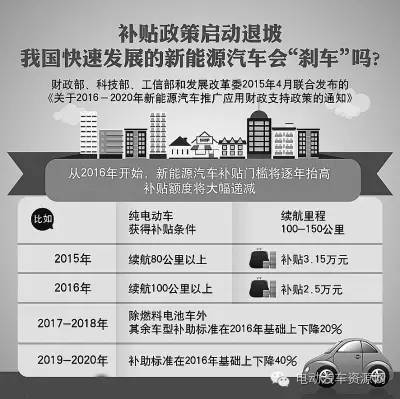According to the latest statistics from the China Association of Automobile Industry, 215,000 new energy vehicles were produced and 207,000 were sold from January to July last year, up 119.8 percent and 122.8 percent respectively from the same period last year.

In 2015, China's spurt of growth put it in the position of the world's largest electric vehicle market, and continued to grow rapidly in 2016. However, in the face of subsidies and regulatory, demand transformation, new energy vehicles can continue to play a leading role?
What kind of a hot dog is that
New Energy vehicles are becoming an important vehicle for a new round of technological revolution. Yin Hejun, vice minister of Science and technology, pointed out that in 2009, in 2015, with the vigorous promotion of the new energy automobile industry by the Central and local governments and the joint efforts of the industry, university and research sectors, the annual output of new energy automobiles in China has rapidly increased from less than 10,000 to more than 300,000 To become the world's largest producer and marketer of new energy vehicles.
According to incomplete statistics, including oil-electric hybrid power, the next three years are expected to have nearly 100 new energy vehicles on the market. The era of electric vehicles for all has arrived, with car manufacturers, Internet companies, start-ups, auto parts and design companies all starting to develop and launch new products, new channels and upend traditional business models. Great Progress HAS BEEN MADE IN R & D and industrialization of New Energy Vehicle Technology in China.
The technology and industrialization of electric vehicles in China are moving faster than people think. The policy of national encouragement and support has been improved, electric technology is gradually accepted by consumers, and the potential consumer population is growing. But overall, this is still a policy driven market, and its unsustainability is beginning to show, said Chen Qingtai, president of the Chinese Association of 100 people for Electric Vehicles.
At present, the development of new energy vehicles in China faces two major challenges: First, whether the process of improving the performance-to-price ratio of electric vehicles can catch up with the process of subsidising the decline of electric vehicles; second, whether the independent-brand electric vehicles can stand on their own feet under the open conditions To compete with foreign brands. Chen Qingtai believes that the key to meet these two challenges is to further break through the core technology, substantially improve the competitiveness of China's electric vehicles.
To deal with the big test of subsidy withdrawal
The 2016 White Paper on New Energy Vehicle Consumers, jointly published by the China Association of Automobile Manufacturers and Nelson, points out that the impact of price subsidies on new energy vehicle purchases can not be ignored Nearly half of prospective consumers value government price subsidies when buying a car.
The declining trend of subsidy policy is forming a strong negative force of positive energy. The subsidy orientation will give way to the market orientation and the innovation orientation. We should cherish and make good use of the recession cycle, and concentrate on building core competitiveness, so that our electric vehicles on the one hand can be comparable with fuel vehicles, on the other hand can compete with international giants.
The financial subsidy policy for new energy vehicles will be adjusted, said Song Qiuling, deputy director-general of the Economic Construction Department of the Ministry of Finance Continuously raising the threshold for enterprises and products to enter the catalogue of recommended models, so that products with advanced technology and high market recognition can receive financial subsidies, and on the contrary, they can not receive subsidies, thus promoting enterprises to accelerate technological progress, promoting superior enterprises to become better and stronger.
Something driving inflection point something will appear
Nelson found that nearly 33% of consumers think new energy vehicles are the trend, and more and more consumers will choose new energy vehicles in the future. According to the motive of buying new energy vehicles, 42% of the prospective consumers are motivated by environmental factors such as low emission.
The development of new energy vehicles, while facing the bottleneck of battery performance, charging facilities, policies and regulations, also has a great prospect of improving environmental awareness, product pull and consumption upgrade.
All kinds of situations show that electric vehicles in China are moving from the introduction period to the growth period. Accordingly, the electric vehicle development power has already arrived by the policy drive to the innovation and the policy double drive the transformation period. The decline of subsidies for car purchases is precisely a shift from government-supported policies to one that promotes innovation. That is, while the subsidy for car purchases is gradually decreasing, the government should increase its support in the R & D sector and focus resources on breaking through technical bottlenecks in power batteries, core components, electronic control technology, lightweight and intellectualization, Chen Qingtai pointed out.
"2016 new energy vehicle consumer white paper" pointed out that the new energy vehicle demand shows diversification and high-end features, new energy vehicle user groups appear young, high-educated, middle-class characteristics, more look forward to the network electric vehicles. The demand for new energy vehicles is expected to reach an inflection point driven by personal consumption upgrade under the subsidy recession and the product pull effect. Safety and charging facilities will also greatly increase the willingness of consumers to buy new energy vehicles.